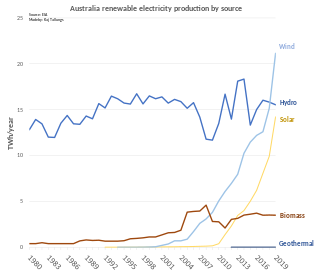This article needs additional citations for verification .(May 2015) |
Mulilo Renewable Energy is a South African company operating in the utility scale energy market in South Africa.
This article needs additional citations for verification .(May 2015) |
Mulilo Renewable Energy is a South African company operating in the utility scale energy market in South Africa.
The company has been active since 2008, and has partnered two Round 1 Solar pv projects in the REIPPP program that started feeding power into the national grid in late 2014.
Currently 4 round three projects are under construction in the Northern Cape province - 2 Solar Photovoltaic plants in Prieska and 2 wind farms near De Aar. [1]

Many countries and territories have installed significant solar power capacity into their electrical grids to supplement or provide an alternative to conventional energy sources. Solar power plants use one of two technologies:

Renewable energy in Australia includes wind power, hydroelectricity, solar photovoltaics, heat pumps, geothermal, wave and solar thermal energy.

The developing nations of Africa are popular locations for the application of renewable energy technology. Currently, many nations already have small-scale solar, wind, and geothermal devices in operation providing energy to urban and rural populations. These types of energy production are especially useful in remote locations because of the excessive cost of transporting electricity from large-scale power plants. The applications of renewable energy technology has the potential to alleviate many of the problems that face Africans every day, especially if done in a sustainable manner that prioritizes human rights.
DESERTEC is a non-profit foundation that focuses on the production of renewable energy in desert regions The project aims to create a global renewable energy plan based on the concept of harnessing sustainable powers, from sites where renewable sources of energy are more abundant, and transferring it through high-voltage direct current transmission to consumption centers. The foundation also works on concepts involving green hydrogen. Multiple types of renewable energy sources are envisioned, but the natural climate of the deserts is key to creating the plan.
Morocco's energy policy is set independently by two agencies of the government: the Office of Hydrocarbons and Mining (ONHYM) which sets domestic oil policy, and the Office National de l'Electricité (ONE), which sets policy with regard to electricity. The two major weaknesses of the energy policy of Morocco are the lack of coordination between these two agencies and the lack of development of domestic energy sources.
Copperton was a mining town in the central Karoo region of South Africa. As a copper and zinc-mining area, Copperton saw its heyday between 1970 and the end of the 20th century, when it housed about 3,000 workers and their families; amenities included a school and recreation facilities, including a golf course.
South Africa has a large energy sector, being the third-largest economy in Africa. The country consumed 227 TWh of electricity in 2018. The vast majority of South Africa's electricity was produced from coal, with the fuel responsible for 88% of production in 2017. South Africa is the 7th largest coal producer in the world. As of July 2018, South Africa had a coal power generation capacity of 39 gigawatts (GW). South Africa is the world's 14th largest emitter of greenhouse gases. South Africa is planning to shift away from coal in the electricity sector and the country produces the most solar and wind energy by terawatt-hours in Africa. The country aims to decommission 34 GW of coal-fired power capacity by 2050. It also aims to build at least 20 GW of renewable power generation capacity by 2030. South Africa aims to generate 77,834 megawatts (MW) of electricity by 2030, with new capacity coming significantly from renewable sources to meet emission reduction targets. Through its goals stated in the Integrated Resource Plan, it announced the Renewable Energy Independent Power Producer Procurement Programme, which aims to increase renewable power generation through private sector investment.

In 2018, Nigeria's primary energy consumption was about 155 Mtoe. Most of the energy comes from traditional biomass and waste, which accounted for 73.5% of total primary consumption in 2018. The rest is from fossil fuels (26.4%) and hydropower.

A photovoltaic power station, also known as a solar park, solar farm, or solar power plant, is a large-scale grid-connected photovoltaic power system designed for the supply of merchant power. They are different from most building-mounted and other decentralized solar power because they supply power at the utility level, rather than to a local user or users. Utility-scale solar is sometimes used to describe this type of project.

Solar power in South Africa includes photovoltaics (PV) as well as concentrated solar power (CSP). In 2016, South Africa had 1,329 MW of installed solar power capacity. Installed capacity is expected to reach 8,400 MW by 2030.
The Jasper Solar Energy Project is a 96 megawatt (MW) photovoltaic power station, located 120 km west of Kimberley, in South Africa's Northern Cape. Construction of the project was completed in October 2014 and it is fully operational to power up to 80,000 homes.

Khi Solar One (KSO) is a solar power tower solar thermal power plant, located in the Northern Cape Region of South Africa. Khi Solar One is 50 megawatts (MW), and is the first solar tower plant in Africa. It covers an area of 140 hectares.

ACWA Power is a developer, investor, co-owner and operator of a portfolio of power generation and desalinated water production plants currently with presence in 10 countries including in the Middle East and North Africa, Southern Africa and South East Asia regions. ACWA Power’s portfolio, with an investment value in excess of USD 33 billion, can generate more than 22 GW of power and produce 2.5 million m3/day of desalinated water to be delivered on a bulk basis to state utilities and industrial majors on long term off-take contracts under Public-Private-Partnership, Concession and Utility Services Outsourcing models (BOO/BOOT).

Bokpoort CSP is a concentrated solar power (CSP) thermal energy power plant, located near Groblershoop in the Northern Cape province of South Africa. The project was procured pursuant to the Renewable Energy Independent Power Producer Procurement (REIPPP) program initiated by the South African Department of Energy.
Building Energy is a vertical integrated renewable energy company that develops, engineers, constructs, and operates projects. The company employs approximately 200 full-time employees and owns a diversified portfolio of renewable assets within solar energy, energy storage, wind energy, biomass and hydropower.
Redstone Solar Thermal Power (RSTP) is a solar power tower with molten salt energy storage, located in Postmasburg, near Kimberley, in the Northern Cape Region of South Africa. Redstone will have a capacity of 100 megawatts (MW) to deliver power to 200,000 people and was awarded in bid window 3.5 of the REIPPP at a strike price of 122.3 ZAR/KWh including time of day pricing in 2015. The project was initially based on the technology of now bankrupt Solar Reserve, but was delayed for several years because the PPA was not signed by Eskom until 2018. After the project was revived the plant is now under construction and the technology will be provided by Brightsource and John Cockerill, as demonstrated in the Noor Energy 1 project in the UAE.

Renewable energy in South Africa is energy generated in South Africa from renewable resources, those that naturally replenish themselves—such as sunlight, wind, tides, waves, rain, biomass, and geothermal heat. Renewable energy focuses on four core areas: electricity generation, air and water heating/cooling, transportation, and rural energy services. The energy sector in South Africa is an important component of global energy regimes due to the country's innovation and advances in renewable energy. South Africa's greenhouse gas (GHG) emissions is ranked as moderate and its per capita emission rate is higher than the global average. Energy demand within the country is expected to rise steadily and double by 2025.

DLO Energy Resources Group (PTY) LTD is an independent power producer headquartered in Johannesburg, South Africa with primary operations in renewable energy, solar power and wind power. Established in 2011, the company currently oversees one of Africa’s largest wind farms located in the Northern Cape of South Africa; powering approximately 160,000 homes with carbon free solar power.
The Prieska–Total Solar Power Station, also Mulilo Prieska Solar Power Station, is an 86 megawatts solar power plant in South Africa. The solar farm was developed and is owned by a consortium comprising five independent power producers (IPPs), development finance companies and private investment firms. The power station owners formed a special purpose vehicle (SPV) company called Mulilo Prieska PV (RF), to design, finance, construct, own, operate and maintain the power station and related infrastructure. The off-taker of the energy generated here is Eskom Holdings, the public electricity utility parastatal of South Africa. A 20-year power purchase agreement between Murillo Prieska PV and Eskom, governs the sale and purchase of electricity between the power station and the electric utility.